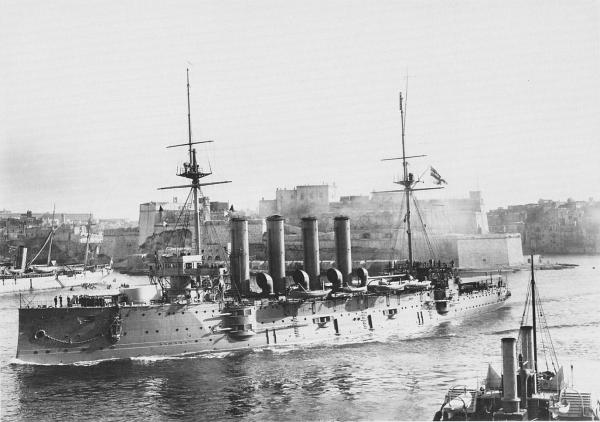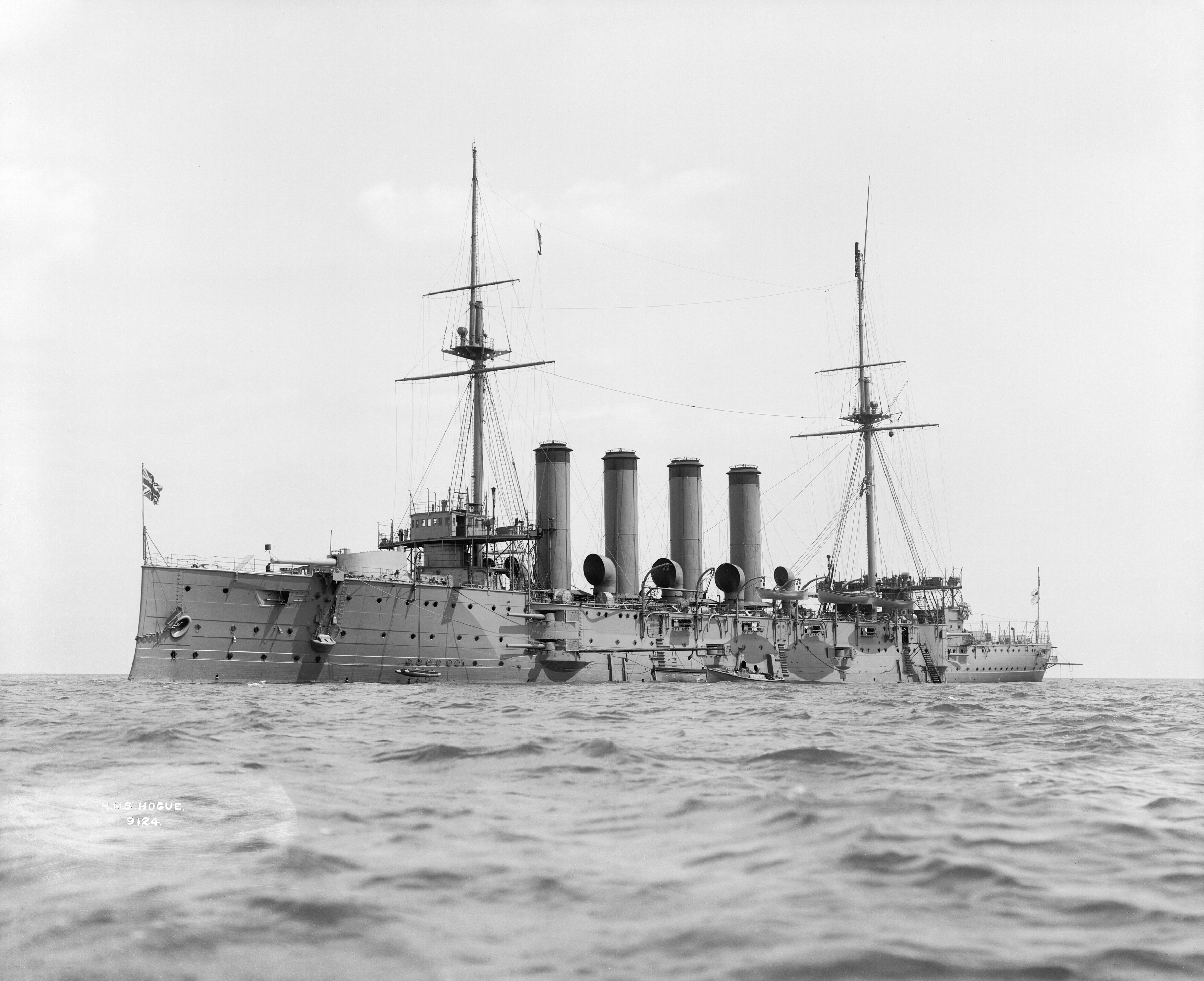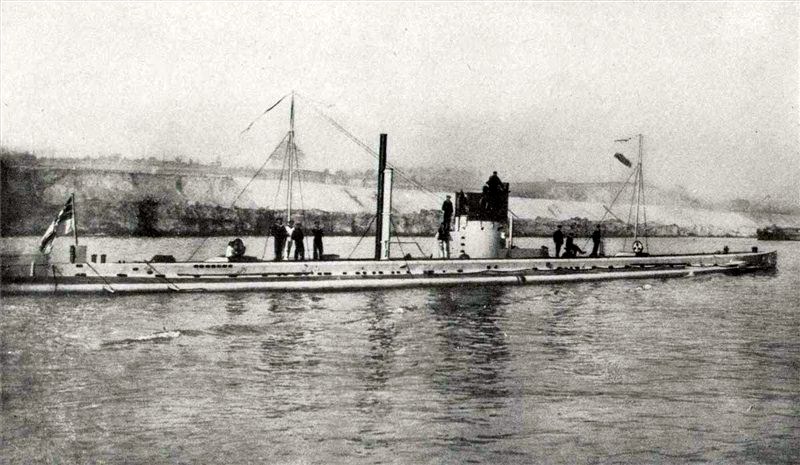Live Bait Squadron on:
[Wikipedia]
[Google]
[Amazon]
The 7th Cruiser Squadron (also known as Cruiser Force C) was a blockading force of the




 Upon the outbreak of war with Germany in 1914, the Second and Third Fleets of the Royal Navy were combined to form a Channel Fleet. The 7th Cruiser Squadron consisted of , , , and . Their task was to patrol the relatively shallow waters of the
Upon the outbreak of war with Germany in 1914, the Second and Third Fleets of the Royal Navy were combined to form a Channel Fleet. The 7th Cruiser Squadron consisted of , , , and . Their task was to patrol the relatively shallow waters of the
Northern Patrol
{{Cruiser squadrons of the Royal Navy, state=collapsed Cruiser squadrons of the Royal Navy Military units and formations of the Royal Navy in World War I North Sea operations of World War I Naval battles of World War I involving the United Kingdom Naval battles of World War I involving Germany
Royal Navy
The Royal Navy (RN) is the United Kingdom's naval warfare force. Although warships were used by English and Scottish kings from the early medieval period, the first major maritime engagements were fought in the Hundred Years' War against ...
during the First World War
World War I (28 July 1914 11 November 1918), often abbreviated as WWI, was one of the deadliest global conflicts in history. Belligerents included much of Europe, the Russian Empire, the United States, and the Ottoman Empire, with fightin ...
used to close the English Channel
The English Channel, "The Sleeve"; nrf, la Maunche, "The Sleeve" (Cotentinais) or ( Jèrriais), (Guernésiais), "The Channel"; br, Mor Breizh, "Sea of Brittany"; cy, Môr Udd, "Lord's Sea"; kw, Mor Bretannek, "British Sea"; nl, Het Kana ...
to German
German(s) may refer to:
* Germany (of or related to)
** Germania (historical use)
* Germans, citizens of Germany, people of German ancestry, or native speakers of the German language
** For citizens of Germany, see also German nationality law
**Ge ...
traffic. It was employed patrolling an area of the North Sea known as the Broad Fourteens in support of vessels guarding the northern entrance to the Channel. The Squadron had been part of the Third Fleet of the Home Fleets.
The squadron came to public attention when on 22 September 1914, three of the cruisers were sunk by one German submarine while on patrol. Approximately 1,460 sailors were killed and there was a public outcry at the losses. The incident eroded confidence in the government and damaged the reputation of the Royal Navy, at a time when many countries were still considering which side they might support in the war.
Creation
The 7th Cruiser Squadron (also Cruiser Force C in 1914) was created at the Nore as part of the reorganisation of theRoyal Navy
The Royal Navy (RN) is the United Kingdom's naval warfare force. Although warships were used by English and Scottish kings from the early medieval period, the first major maritime engagements were fought in the Hundred Years' War against ...
's home fleets which took effect on 1 May 1912. It formed part of the Third Fleet of the Home Fleets and effectively served as a reserve force stationed on the south coast of England. The squadron was composed mainly of five of the six armoured cruisers, which had been transferred from the 6th Cruiser Squadron of the former divisional structure of the Home Fleets, and already considered obsolescent despite being fewer than 12 years old. Their status meant that most of the time they were manned by "nucleus crews" an innovation introduced by Admiral John "Jackie" Fisher a few years earlier. Their ships' complements of 700 men plus officers were only brought up to full strength for manœuvres or mobilisation. The nucleus crews were expected to keep the ships in a seaworthy condition the rest of the time.
The 1913 manœuvres illustrate the system. In June, the command of squadrons was announced by the Admiralty. As a reserve formation, the 7th Cruiser Squadron had no flag officer until 10 June, when Rear-Admiral Gordon Moore
Gordon Earle Moore (born January 3, 1929) is an American businessman, engineer, and the co-founder and chairman emeritus of Intel Corporation. He is also the original proponent of Moore's law.
As of March 2021, Moore's net worth is repor ...
—Third Sea Lord
The post of Controller of the Navy (abbreviated as CofN) was originally created in 1859 when the Surveyor of the Navy's title changed to Controller of the Navy. In 1869 the controller's office was abolished and its duties were assumed by that of ...
—was given the command upon taking leave from the Admiralty. He hoisted his flag in ''Bacchante'' on 15 July. All ships of the squadron would have been brought up to strength with men from other parts of the navy and from the Royal Naval Reserve
The Royal Naval Reserve (RNR) is one of the two volunteer reserve forces of the Royal Navy in the United Kingdom. Together with the Royal Marines Reserve, they form the Maritime Reserve. The present RNR was formed by merging the original Ro ...
. The manœuvres took place and on 9 August Rear-Admiral Moore struck his flag and on the 16th the squadron was reduced back to reserve commission.
First World War




 Upon the outbreak of war with Germany in 1914, the Second and Third Fleets of the Royal Navy were combined to form a Channel Fleet. The 7th Cruiser Squadron consisted of , , , and . Their task was to patrol the relatively shallow waters of the
Upon the outbreak of war with Germany in 1914, the Second and Third Fleets of the Royal Navy were combined to form a Channel Fleet. The 7th Cruiser Squadron consisted of , , , and . Their task was to patrol the relatively shallow waters of the Dogger Bank
Dogger Bank (Dutch: ''Doggersbank'', German: ''Doggerbank'', Danish: ''Doggerbanke'') is a large sandbank in a shallow area of the North Sea about off the east coast of England.
During the last ice age the bank was part of a large landmass ...
and the Broad Fourteens in the North Sea, supported by destroyers of the Harwich Force
The Harwich Force originally called Harwich Striking Force was a squadron of the Royal Navy, formed during the First World War and based in Harwich. It played a significant role in the war.
History
After the outbreak of the First World War, a ...
. The aim was to protect ships carrying supplies between Britain and France against German ships operating from the northern German naval ports.
Although the cruisers had been designed for a speed of , wear and tear meant they could now only manage at most and more typically only . Bad weather sometimes meant that the smaller destroyers could not sail and at such times the cruisers would patrol alone. A continuous patrol was maintained with some ships on station, while others returned to harbour for coal and supplies.
From 26–28 August 1914, the squadron was held in reserve during the operations which led to the Battle of Heligoland Bight.
The Live Bait Squadron
On 21 August, CommodoreRoger Keyes
Admiral of the Fleet Roger John Brownlow Keyes, 1st Baron Keyes, (4 October 1872 – 26 December 1945) was a British naval officer.
As a junior officer he served in a corvette operating from Zanzibar on slavery suppression missions. Ea ...
—commanding a submarine squadron also stationed at Harwich—wrote to his superior Admiral Sir Arthur Leveson warning that in his opinion the ships were at extreme risk of attack and sinking by German ships because of their age and inexperienced crews. The risk to the ships was so severe that they had earned the nickname "the live bait squadron" within the fleet. By 17 September, the note reached the attention of First Lord of the Admiralty
The First Lord of the Admiralty, or formally the Office of the First Lord of the Admiralty, was the political head of the English and later British Royal Navy. He was the government's senior adviser on all naval affairs, responsible for the di ...
Winston Churchill
Sir Winston Leonard Spencer Churchill (30 November 187424 January 1965) was a British statesman, soldier, and writer who served as Prime Minister of the United Kingdom twice, from 1940 to 1945 during the Second World War, and again from ...
who met with Keyes and Commodore Reginald Tyrwhitt
Admiral of the Fleet Sir Reginald Yorke Tyrwhitt, 1st Baronet, (; 10 May 1870 – 30 May 1951) was a Royal Navy officer. During the First World War he served as commander of the Harwich Force. He led a supporting naval force of 31 destroyers a ...
—commander of a destroyer squadron operating from Harwich—while travelling to Scapa Flow to visit the Grand Fleet
The Grand Fleet was the main battlefleet of the Royal Navy during the First World War. It was established in August 1914 and disbanded in April 1919. Its main base was Scapa Flow in the Orkney Islands.
History
Formed in August 1914 from the F ...
on 18 September. Churchill—in consultation with the First Sea Lord
The First Sea Lord and Chief of the Naval Staff (1SL/CNS) is the military head of the Royal Navy and Naval Service of the United Kingdom. The First Sea Lord is usually the highest ranking and most senior admiral to serve in the British Armed Fo ...
Prince Louis of Battenberg
Admiral of the Fleet Louis Alexander Mountbatten, 1st Marquess of Milford Haven, (24 May 185411 September 1921), formerly Prince Louis Alexander of Battenberg, was a British naval officer and German prince related by marriage to the British ...
—agreed that the cruisers should be withdrawn and wrote a memo stating:
Vice Admiral Frederick Sturdee—chief of the Admiralty war staff—objected that, while the cruisers should be replaced, no modern ships were available and the older vessels were the only ships that could be used during bad weather. It was therefore agreed between Battenberg and Sturdee to leave them on station until the arrival of new cruisers then being built.
Sinking of three cruisers
At around 06:00 on 22 September, the three cruisers ''Aboukir'', ''Cressy'' and ''Hogue'' were steaming, alone, at in line ahead. The 7th Cruiser Squadron flagship, their sister ship ''Euryalus'', as well as theirlight cruiser
A light cruiser is a type of small or medium-sized warship. The term is a shortening of the phrase "light armored cruiser", describing a small ship that carried armor in the same way as an armored cruiser: a protective belt and deck. Prior to th ...
and destroyer screen, had been forced temporarily to return to base, leaving the three obsolete cruisers on their own.Archibald (1984). p. 197. They were spotted by the German submarine , commanded by Lt. Otto Weddigen. They were not zigzagging but all of the ships had lookouts posted to search for periscopes and one gun on each side of each ship was manned.
Weddigen ordered his submarine to submerge and closed the range with the unsuspecting British ships. At close range, he fired a torpedo
A modern torpedo is an underwater ranged weapon launched above or below the water surface, self-propelled towards a target, and with an explosive warhead designed to detonate either on contact with or in proximity to the target. Historically, s ...
at ''Aboukir''. The torpedo broke the back of ''Aboukir'' and she sank within 20 minutes with the loss of 527 men. The captains of ''Cressy'' and ''Hogue'' thought ''Aboukir'' had struck a floating mine and came forward to assist her. ''Hogue'' hove to and began to pick up survivors. Weddigen fired two torpedoes into ''Hogue'', mortally wounding her but the submarine surfaced and was fired upon. As ''Hogue'' sank, the captain of ''Cressy'' knew that the squadron was being attacked by a submarine and should have tried to flee; this was not yet considered the proper action to take. ''Cressy'' came to a stop amongst the survivors; Weddigen fired two more torpedoes into ''Cressy'' and sank her as well.
Dutch ships were nearby and destroyers from Harwich were brought to the scene by distress signals; the brave intervention of two Dutch coasters and an English trawler prevented the loss from being even greater than it was. The rescue vessels saved 837 men but of the crews, 1,397 men and 62 officers, were lost. A term (class) of Dartmouth naval cadets was aboard these ships, and many of the cadets were lost in the disaster.
Aftermath
Otto Weddigen returned to Germany as the first naval hero of the war and was awarded theIron Cross
The Iron Cross (german: link=no, Eisernes Kreuz, , abbreviated EK) was a military decoration in the Kingdom of Prussia, and later in the German Empire (1871–1918) and Nazi Germany (1933–1945). King Frederick William III of Prussia es ...
, Second and First Class. Each member of his crew received the Iron Cross, Second Class. The German achievement shook the reputation of the British navy throughout the world. Despite the age of ''Cressy''-class vessels, many Britons did not believe the sinking of three large armoured ships could have been the work of one submarine but that other submarines and perhaps other non-British craft must have been involved. Admirals Beatty and Fisher spoke out against the folly of placing such ships where they had been. Churchill was widely blamed by the public for the disaster despite his memo of 18 September that the older ships should not be used in the venture.
Rear-Admiral Arthur Christian was suspended on half pay and later reinstated by Battenberg. Drummond was criticised for not zig-zagging to shake off submarines and for not requesting destroyer support as soon as the weather improved. Zig-zagging had not been taken seriously by ships' captains who had not experienced submarine attacks; the tactic thereafter was made compulsory in dangerous waters. All big warships were instructed never to approach a ship severely disabled by mine or torpedo but to steam away and leave the rescue to smaller vessels.
Three weeks later, the German war hero Weddigen—now operating ''U-9'' off Aberdeen
Aberdeen (; sco, Aiberdeen ; gd, Obar Dheathain ; la, Aberdonia) is a city in North East Scotland, and is the third most populous city in the country. Aberdeen is one of Scotland's 32 local government council areas (as Aberdeen City), and ...
—torpedoed and sank , another British cruiser that was not zig-zagging in hostile waters. Weddigen was killed in March 1915 during a German raid in the Pentland Firth
The Pentland Firth ( gd, An Caol Arcach, meaning the Orcadian Strait) is a strait which separates the Orkney Islands from Caithness in the north of Scotland. Despite the name, it is not a firth.
Etymology
The name is presumed to be a corrup ...
when his submarine——was intentionally rammed by the battleship . The remaining ''Cressy'' class ships were dispersed from the British Isles. The remnants of the 7th Cruiser Squadron was reconstituted the following year as part of the Grand Fleet, which contained many better armoured and more modern ships than ''Bacchantes'' but in 1916 the 7th was disbanded again. It did not see service at the Battle of Jutland.
Second World War
The squadron was reformed for the third time on 18 July 1940 and was placed under the command of Rear-Admiral, Edward de Faye Renouf. It was a unit within theNorthern Patrol
The Northern Patrol, also known as Cruiser Force B and the Northern Patrol Force, was an operation of the British Royal Navy during the First World War and Second World War. The Patrol was part of the British "distant" blockade of Germany. Its ma ...
then under the command of Vice Admiral Sir Max Horton
Admiral Sir Max Kennedy Horton, (29 November 1883 – 30 July 1951) was a British submariner during the First World War and commander-in-chief of the Western Approaches in the later half of the Second World War, responsible for British partici ...
. In March 1941 the squadron was disbanded.
Rear-Admirals commanding
Included:Notes
References
* * * * * * * *External links
Northern Patrol
{{Cruiser squadrons of the Royal Navy, state=collapsed Cruiser squadrons of the Royal Navy Military units and formations of the Royal Navy in World War I North Sea operations of World War I Naval battles of World War I involving the United Kingdom Naval battles of World War I involving Germany